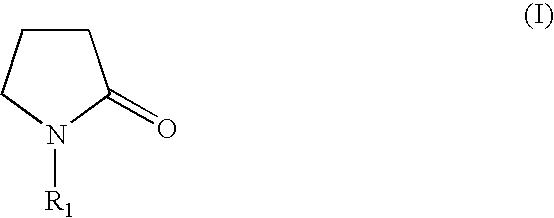Method of forming fine patterns
- Summary
- Abstract
- Description
- Claims
- Application Information
AI Technical Summary
Benefits of technology
Problems solved by technology
Method used
Image
Examples
example 1
[0068] A copolymer including polyacrylate (PAA) and polyvinylpyrrolidone (PVP) [2 g: PAA / PVP=2:1 (polymerization ratio)], triethanolamine (0.18 g) and a polyoxyethyelene phosphate ester surfactant (0.02 g; "PLYSURF A210G", product of Dai-ichi Kogyo Seiyaku Co, Ltd.) were dissolved in water (52 g) to prepare an over-coating agent.
[0069] A substrate (8-inch diameter) was whirl coated with a positive-acting photoresist TDUR-PO36PM (product of Tokyo Ohka Kogyo Co., Ltd.) and baked at 80.degree. C. for 90 seconds to form a photoresist layer in a thickness of 0.48 .mu.m.
[0070] The photoresist layer was exposed with an exposure unit (Canon EPA-3000EX3, product of Canon Inc.), subjected to heat treatment at 120.degree. C. for 90 seconds and developed with an aqueous solution of 2.38 mass % TMAH (tetramethylammonium hydroxide) to form photoresist patterns which defined hole patterns with an each diameter of 178.9 nm (i.e., the spacing between the photoresist patterns, or the initial hole dim...
example 2
[0072] The same procedure as described in Example 1 was repeated, except that the substrate was brought into contact with pure water by dropping it on the substrate for 90 seconds. Each diameter of the hole patterns was narrowed to 158.3 nm, and few defects were occurred on the entire substrate
PUM
 Login to View More
Login to View More Abstract
Description
Claims
Application Information
 Login to View More
Login to View More - R&D
- Intellectual Property
- Life Sciences
- Materials
- Tech Scout
- Unparalleled Data Quality
- Higher Quality Content
- 60% Fewer Hallucinations
Browse by: Latest US Patents, China's latest patents, Technical Efficacy Thesaurus, Application Domain, Technology Topic, Popular Technical Reports.
© 2025 PatSnap. All rights reserved.Legal|Privacy policy|Modern Slavery Act Transparency Statement|Sitemap|About US| Contact US: help@patsnap.com



